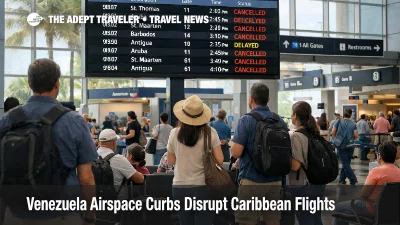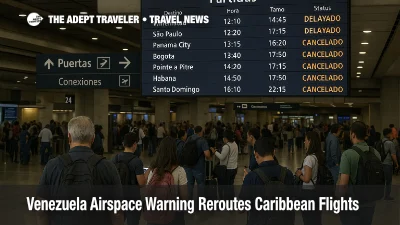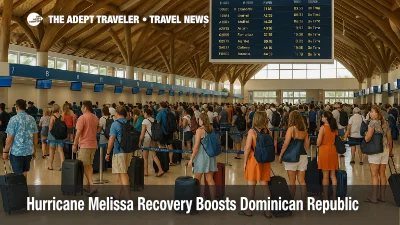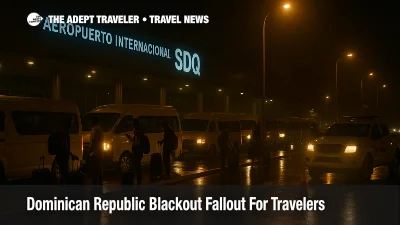Dominican Republic
Travel to the Dominican Republic can feel like stepping into a tapestry of color, sound, and life that you didn't even know existed—or maybe you did, think of those postcard-perfect beaches and the smell of fresh coconuts mingling with salty sea air. I mean, there's something about the lush greenery meeting the endless turquoise of the Caribbean Sea that just sparks an odd kind of excitement, like rediscovering something simultaneously foreign and familiar. And those sugar-powdered beaches, there's more to them than just lounging; picture yourself tasting the tangy burst of fresh mangos or hearing the energetic rhythm of merengue spilling onto the streets. Oh, let’s not forget the bustling markets where the air is thick with the aroma of sizzling plantains mixed with the gentle hum of locals chatting; it’s not quite chaos, just a lively symphony of life, a different tune than you might expect. And come to think of it, isn't part of the charm realizing that while you aimlessly wander the cobblestone streets of Santo Domingo—hunting for hidden gems, you're really just diving deeper into the island's soul? The idea of travel, as I see it, is less about landmarks and more about those unexpected moments, like hearing a familiar song played on a street corner in, quite frankly, a way that hits different. When it comes down to it, doesn't travel always promise transformation, if only in small, subtle ways? So, venturing to the Dominican Republic isn't merely a trip; it's almost like setting foot onto pages of a living story, yours to write, endlessly captivating yet irresistibly inviting you to explore more.
Dominican Republic Travel Season
When we talk about the best time for a trip to the Dominican Republic, it's a dance of weather, crowds, and economy. Peak season, of course, ties itself to the winter months, roughly December through April. Everyone flocks to escape the cold. It's like a magnetic pull, right? But when you think about it, being there with all those crowds may not actually be every traveler’s dream scenario. The beaches are vibrant and bustling, sure, but sometimes I wonder if we miss out on those serene moments in the sand.
Ah, the elusive shoulder season. Late spring, May especially, and just before—the shoulder months of late fall, October, and November—are kind of like that best-kept secret for travel to the Dominican Republic. Maybe the weather's a bit more humid than peak times, but it's still very pleasant, and you're avoiding the bulk of the tourist tsunami. Come to think of it, the rains pop up occasionally, yes, but they're this refreshing kind that cleanses the air and then, poof, they're gone. It's also that delightful time when you might find a beach to yourself, like a little enclave of personal paradise.
Now, if you're the traveler who thrives on experiences infused with culture and authenticity, visiting during a local festival presents a unique flavor. Dominicans are lively. Their festivals, like Carnival in February or Merengue Festival in July, unravel in vivid tapestries of music and dancing. It's a different rhythm when you travel to the Dominican Republic during these celebrations—get swept up in a kind of local whirlwind. When I think about how these cultural dynamics add layers to visiting, it’s fascinating really. They transform an ordinary trip into a colorful tapestry of sights and sounds.
Let’s flip this a bit and play devil’s advocate. Some might argue that off-peak times risk missing out on the quintessential “perfect weather” image that’s sold to us in glossy brochures. You know, where the sun shines without a cloud? Yet, there’s something to be said for seeking out those imperfect days when clouds drift by if it means dodging the elbow-to-elbow chaos. To some extent, you get to experience the quieter side of the Dominican Republic. It makes me ponder how personal preferences always challenge these general travel truths we’ve come to accept.
Spring and fall also bring their perks with less crowded historical sites and eco-adventures just waiting for the curious visitor. Imagine getting to wave off the massive tour groups when venturing to places like Los Haitises National Park. The experience morphs into a more intimate discovery event, less rushed, more personal. And honestly, the tropical scenery remains a constant. Lush. Vibrant. It’s amusing that it’s consistent through any season. Almost as if the island itself is inviting you to enjoy at its own pace.
Reflecting on the different periods to travel to the Dominican Republic, it's odd how choices unravel. The shoulder seasons make you feel like a bit of an adventurer, a time traveler slipping between peaks and troughs, seeking the balance between experience and solitude. I sometimes wonder if those hurried peak moments are less about the spirit of travel and more about the rush seen in life generally. All in all, navigating the seasons is your own personal adventure, as preferences swirl and adapt with each idea considered. That balance of solace and socializing, of discovery and relaxation, becomes an unpredictable yet enchanting journey.
The Weather and Seasons in Dominican Republic
So, the weather in the Dominican Republic—it's kind of a mix, you know? It’s this whole symphony of tropical climate, characterized by its warmth and humidity. Throughout the year—more or less—it dances along a steady path of warm temperatures, ranging from about 75°F (24°C) to 90°F (32°C). Ah, but it can throw you for a loop sometimes. Temperature might surprise you here or there, but largely, its pretty consistent, which, come to think of it, can be a comfort.
What's the Deal with Seasons?
Contrary to what some might assume—because let's face it, the words 'tropical paradise' conjure up endless sunny skies—there’s a bit more nuance here. There are two main seasons in the Dominican Republic: the dry season, and then there’s the wet season. From November to April, you get the dry season. Not as much rain, clear skies—ideal for travel to the Dominican Republic. It’s a good time, perhaps slightly cooler, and less humid, if that's your thing. However, it’s odd that I’m calling it cooler when it’s still relatively warm. Between December and February, temperatures dip a bit to 68°F (20°C) at night. This is when the beaches are blissfully packed with eager travelers.
On the flip side, and this might catch some travelers off guard, May through October is the wet season. Rainfall can be heavy, and hurricanes, though more common from June to November, can sometimes crash the party. Maybe this is not the best time to travel to the Dominican Republic, or maybe it is, depending on what you're after. Showers might abruptly pour down, only to clear just as quickly. Temperatures still reside in that tropical spectrum—highs average 88°F (31°C). Though it might sound like a deterrent, the wet season has its own charm. The landscape is lush, vibrant—alive!
Travel Optimally to Dominican Republic
For those planning their travel to Dominican Republic, eyeing the best conditions, the optimal time is—is really the dry season, I’d say. November through April shines, offering just the right blend of warmth and relative dryness. And, you get to skip the humidity, well, the oppressive kind anyway. But another thought—maybe there’s more to consider here. Travel when it's low season, when it's wet. Maybe that offers something unexpected, albeit partially soggy. You might find the beaches less crowded, prices a tad lower. Maybe.
As for humidity, expect it to be—well, always a companion, sometimes comforting, other times, suffocating. Even during the drier months, it can sneak up on you. What’s interesting is how the locals, who should be experts at this point, navigate the weather. It’s almost a dance, in step with the rhythm of the tropical climate. Reflecting on that, perhaps the Dominican Republic, in all its weather eccentricity, offers a lesson in adapting, pivoting, flowing. It's odd, isn't it?
Unexpected Events and Weather Tied to Culture
Sometimes, the weather doesn’t just influence travel plans or what you pack, it intertwines with the culture, the events. Consider how the Dominican Republic adjusts its sails for hurricane season. It’s a time marked by preparedness but also community, resilience. Or the way carnivals—spread throughout the year—rival even the balmiest of days with their vibrant, intense celebrations. How do they say it? Rain or shine. Perhaps that's an apt mantra for travel to Dominican Republic.
Yet, there's a question that hovers—does the allure lie in the predictability of its warm sun or in the unpredictable intricacies of its weather patterns? And as I write this, caught in my stream-of-consciousness, I wonder if maybe the blend of both is the real magic. It's that constant interplay of anticipation and surprise that keeps the Dominican Republic intriguing. Or maybe I'm just drifting on a tangent again. Funny how that happens.
Accepted Payment Methods and Other Payment Information in Dominican Republic
When you travel to Dominican Republic, the first thing that pops into your head, or maybe it doesn't at all, is the local currency. The Dominican peso is the official currency, and it's interesting how adapting to it might require some mental juggling. Why? Because every now and then, you find yourself converting in your head, wondering if you got the best value for your money. It's odd, really, how our minds work when we're faced with new currencies. In any case, you'll want to get familiar with the peso if your plan is to experience all those colorful markets and local shindigs.
Credit cards? For sure, they’re pretty much accepted everywhere, but with a twist. Visa and Mastercard seem to be the celebrity picks among locals and tourists. American Express, too, although in some secluded spots, it might just give you the cold shoulder. Ah, and let's not forget Discover. It’s not exactly everyone’s favorite child and might have a hard time making an entrance. Funny how certain cards feel right at home, yet others are like a fish out of water. So, keeping that in mind, it's best to have a couple of options at hand when exploring the nooks and crannies of the Dominican Republic.
Cash - oh yes, the sweet jingle of coins and the crinkle of notes. It's still king in many parts. Cash is practical for spur-of-the-moment street foods or skimpy change situations, where a card just feels like an overreaction. I must say, come to think of it, there’s something nostalgic about paying with cash, reminding one of an older, maybe simpler, time. Carrying cash might seem counter to the modern, sleek tap of a card, but it’s oddly comforting. For tips, it's customary to give around 10% in restaurants, unless the service charge is already included. Can't lie, sometimes tipping customs confuse me wherever I go, always keeping me on my toes, second-guessing if I've done it right.
You might wonder about those little cafés and beach shacks—would they even want your card? Or make you jump through hoops to accept it? Well, you'll find that many small businesses are still warming up to the idea of plastic. Not that they're opposed, maybe just set in their ways. And who knows, there might be a day when the balance tips completely in favor of the digital. But for now, maybe bring some pesos for those off-the-beaten-path gems; they might treat you better.
Travel to Dominican Republic might bring surprises, but in a delightful, unexpected way. It’s almost as if the place nudges you to pause, rethink, and adapt, not just to their currency or payment habits, but to their leisurely rhythm as well. And as you weave through, you might even begin to question your own habits. I mean, I sometimes find myself at a crossroad regarding how payments reflect our values. Is the ease of swiping a card making us less grounded? Or is it freeing us for better adventures? I don't know, but there's beauty in pondering such thoughts. And before you know it, you've adjusted without even realizing it. The Dominican Republic has that effect on a person, much like an easy-going friend who's more than just his or her quirks. At times you want to give in to that laid-back, laissez-faire attitude and just see where it leads. Try it out sometime—travel offers the best kind of revelations.
Why You Should Travel to Dominican Republic
Travel to the Dominican Republic and you'll find a destination that offers an array of experiences that are not only diverse but also deeply rooted in the essence of the Caribbean charm. The Dominican Republic, with its inviting landscapes and rich culture, beckons travelers who crave both relaxation and adventure. It’s not just the palm-fringed beaches that make it special; there’s much more simmering beneath the surface.
Paradise Beaches Await You
The beaches in the Dominican Republic are legendary. Sure, every travel destination boasts about having the best sand and surf, but here, the beaches really do live up to the hype. Picture miles and miles of white sand, azure waters gently lapping at the shore, and coconut palms swaying in the breeze. It's funny — you hear these descriptions all the time — but until you actually feel the sand between your toes and see that horizon, you can't quite imagine it. Punta Cana and Puerto Plata offer sun-kissed stretches that lure tourists from every corner of the world. Come to think of it, there's something oddly therapeutic about listening to waves that’s hard to put into words.
Diverse Culture & Lively Traditions
There's something deeply captivating about the culture in the Dominican Republic. It's vibrant, colorful, and always seems to pulse with energy. I mean, it's not like many other places where culture feels like it’s only found in museums — here it's living and breathing. The merengue and bachata music is infectious, and before you know it, you’re caught up in the rhythm. It's odd — you might think you need to know the dance, but more importantly, you just need to feel it. Engaging with local festivals and celebrations, like the Carnaval Dominicano, is a phenomenal way to understand the local spirit and zest for life.
Gastronomic Delight: Flavors That Linger
Food isn't just sustenance; in the Dominican Republic, it's an experience. The local cuisine is a delightful fusion of Spanish, African, and Taíno influences. Honestly, it’s a feast for the senses. From the savory aromas of a freshly made sancocho to the sweet indulgence of a mangú, each dish is a bite into the island's history. And let's not forget the fresh seafood — I once had grilled lobster by the beach, and even now, as I think about it, my mouth waters. It’s funny how some meals stick with you forever. Travel to the Dominican Republic, and you literally taste the journey.
Rich History and Architectural Wonders
In the heart of Santo Domingo, the capital city of the Dominican Republic, lies the Zona Colonial. Walking through these cobblestone streets, it feels like stepping back in time. It's surreal. These are the same paths that Columbus walked! The area is filled with beautifully preserved historic buildings and museums, each telling a story of conquest, colonization, and revolution. There’s this odd juxtaposition of old and new, with churches from the 16th century sitting near buzzing modern eateries. It's a place where past and present merge seamlessly.
A Nature Lover's Playground
You might think of the Dominican Republic as just beaches, but remember, it's more than that. There’s such a diverse range of landscapes! From the verdant rainforests of Los Haitises National Park to the expansive salt flats of Bahía de las Águilas, nature showcases its wonders everywhere. And, excuse me for being cliché for a moment, but the waterfalls — you have to see them! El Limón Waterfall, for instance, is just breathtaking. Hiking through forests to find these hidden gems is incredibly rewarding. It's these unexpected natural wonders that really make traveling here something special.
Warmth of the Dominican People
The warmth of the Dominican Republic isn't just in its climate or its tropical weather. No, it's in the people. The locals, known for their friendliness and warm hospitality, are always ready to share a smile or offer directions. I remember once asking for directions and, instead of just pointing, someone literally walked with me for two blocks to make sure I found my destination. It’s a bit uncanny, really. That level of hospitality seems rare these days. Often, it's the small encounters with people that leave the lasting impressions.
Outdoor Adventures and Water Activities
Adrenaline junkies, rejoice! The Dominican Republic offers an exhilarating array of activities. Whether it's zip-lining over lush jungles, kitesurfing on the beaches of Cabarete, or diving into underwater caves, the thrill is undeniable. Come to think of it, my heart still races when I think about parasailing over the sparkling blue waters. There's something so freeing, albeit slightly terrifying, about seeing the world from above. Even if you're not a thrill-seeker, trying something new and adventurous can be surprisingly refreshing.
Unique Ecotourism Opportunities
Ecotourism is thriving in the Dominican Republic. With national parks, sanctuaries, and protected areas, it provides a window into the unique ecosystems of the Caribbean. Did you know you can go bird watching and encounter species that only exist in this part of the world? And then there's the whale watching in Samaná Bay, which is majestic, to say the least. I’ve often thought that if I were ever to return as a bird or whale, I’d want it to be in waters this pristine.
Dynamic Nightlife and Entertainment
The Dominican Republic is as lively by night as by day. It's quite something — from the pulsating nightclubs in Punta Cana to the relaxed beachfront bars, there’s a spot for every mood. Music is a huge part of the experience, and, well, there's no resisting it. You can dance the night away to the beats of reggaeton or bachata, or simply enjoy a quiet night with live jazz. A night out here is not just about partying; it's about experiencing the vibrancy and vivacity of the local culture.
Golfing in a Tropical Paradise
Golf enthusiasts will find their haven here. Some of the world’s top, and should I say, most breathtaking golf courses are in the Dominican Republic. Imagine teeing off with the ocean as your backdrop. It’s a golfer's dream, really. Courses designed by legends like Jack Nicklaus and Pete Dye are meticulously crafted to challenge and excite players. Travel to the Dominican Republic, and you'll find every swing accompanied by a view that could easily be on a postcard. And isn't that the perfect blend of leisure and sport?
The History of Dominican Republic
The Dominican Republic, now there's a place that should be on every history enthusiast's radar. When you travel to the Dominican Republic, you're diving into a tapestry of events spanning over 500 years, which feels quite rare in our fast-paced world, don't you think? It's curious how a land, once a simple stopover for Columbus, now stands as a monument of the New World. I often find myself musing about how the whole, daring saga of global exploration was kicked off here. It was back in 1492 when Columbus landed on this great island, naming it La Española. And boom, the age of European conquest in the Americas had officially begun. Oddly enough, thinking about it, it's both troubling and intriguing how such small events have rippling effects that shape entire continents. It’s something that really gets you thinking about the passage of time, how this small island played such a big role in history.
Jump forward a century and bits, and you've got something really significant. Santo Domingo, the capital of the Dominican Republic, stakes its claim as the oldest continuously inhabited European settlement in the Americas. Walking down the cobblestone streets of the Zona Colonial feels like stepping back in time. You can almost hear the clop of horse hooves on the stone. There's the stunning Catedral Primada de América, a masterpiece standing proud as the first cathedral built in the New World. You know, standing there, you're physically touching a piece of a story that predates the existence of modern nations as we know them. It's like being in a storybook, but one that's real and tangible. Some kind of time travel, if you will. And yet, as one might consider, aren't we all kind of time travelers, tied to the echoes of a place's past?
As you explore the Dominican Republic, the layers of history just keep unraveling. Let me tell you, even beyond those original colonial footprints, there's a rich tapestry woven with Taíno and African influences, adding flavors to the Dominican culture like the notes in a complex song. Have you ever tried mangú? This traditional dish, made from mashed plantains, reflects the African influences on Dominican cuisine. And then there’s Merengue and Bachata, with their irresistible rhythms that pulse through the streets, beckoning travelers to join in. Sometimes, it makes one wonder about how music connects us to history in ways that books never can. It's fascinating, right, the way strands of heritage thread together with everyday life? It's bewildering how those echoes of history live on through celebrations and flavors. Or maybe that's just me romanticizing it all. Who knows?
But let's fast-forward to more recent times, because it's not all ancient history. The 20th century wasn't exactly kind to the Dominican Republic, marked by the long and tumultuous regime of Rafael Trujillo. And that's putting it lightly. Sometimes, as one reflects on it, it's astonishing how such a dark period could birth a resilient spirit into modern identity. It's somewhat like the human spirit on a grand scale, bouncing back, persisting, and evolving. And now, history buffs might appreciate how recent policies have steered the country towards vibrant economic and cultural growth. In a way, visiting the Dominican Republic becomes a unique narrative experience because you're standing in a place that’s continuously redefining itself, all while embracing its profound historical identity. There's something so... engaging about witnessing history in motion. It's funny, these thoughts trip over each other in their eagerness to be explored. Or maybe it's just me thinking out loud too much. But who's to say, really? Anyway, it's those layers of transformation that make travel to the Dominican Republic so captivating for those who appreciate the continuum of history. It's a destination that feels like it's conversing with its past while constantly looking toward its future. So, if history's your thing—or even if it isn't—Dominican Republic is just where you should be.
The Culture of Dominican Republic
Travel to the Dominican Republic, and you’ll find yourself swept up in a world that's as vibrant as it is diverse. It’s a land where history merges seamlessly with the present, where the old ways of life are still celebrated, cherished even. Dominicans have a way of celebrating life that’s almost contagious— colorfully spirited festivals dot the calendar, with Carnival in February holding the crown jewel title. This is a place where traditions become the heartbeat of everyday life, driving the rhythm of both slow afternoons and lively nights. Somehow, when I think about it, I remember the mesmerizing sway of bachata and merengue, integral cultural expressions that tell so much about the people. These dances are not just pastimes; they're living stories that share the genuine camaraderie and joy of the people who call the Dominican Republic home. It’s actually kind of strange, yet deeply beautiful, how music can sometimes say so much more than words ever could.
There's a multicultural tapestry that makes the Dominican Republic’s culture feel so expansive. You know, this blend of influences—African, Taino, and European—seems like the kind of diversity that can make one pause and think about how beautifully tangled human histories are. Everyday customs are a fascinating glimpse into this blend as well. The streets are peppered with street vendors selling everything from empanadas to fresh coconuts, little scenes that whisper stories from another time if you listen closely. Actually, come to think of it, the cuisine itself is a testament to how cultures can intertwine and create something entirely unique yet comforting. In a way, it’s intriguing how food becomes a language of its own. Don’t you just love how flavors can, quite literally, bring the world together on a single plate?
Art in the Dominican Republic is an expressive force, evident in the murals and galleries that scatter the cities with bursts of color and soul. Artists find inspiration everywhere—perhaps it’s in the serene beauty of the beaches, the sway of palm trees, or the echo of traditional stories still told by the elderly. Sometimes you’ll find modern art juxtaposed with age-old techniques, reminding us that the past and present are always in conversation. Sometimes I wonder if it’s the landscapes that nurture such creativity, or if it’s simply in the air. How fascinating it is when creativity becomes a lens through which to view cultural identity. The presence of indigenous culture may not be overwhelmingly prominent, yet the efforts to preserve Taino heritage reflect a conscious effort to honor the paths walked by ancestors. It’s like they’re painting with history itself, capturing timelessness on canvas.
Travel to the Dominican Republic, and you’ll find yourself dancing to the beats of a culture that is unapologetically vibrant and palpably alive. It's a culture that's complex, yet inviting, welcoming travelers to share in its riches, if only for a little while. Feel the Dominican warmth in the laughter echoing in a colmado or corner store, where friendly debates might erupt over a game of dominoes. It’s odd when you think about it, how such a small country can encapsulate such a vast range of emotions and experiences. It’s a cacophony and yet, a beautiful melody all at once. Visitors should consider not just seeing the sights but becoming part of this rhythm, even if just temporarily. Because those experiences—tapped toes, shared smiles, the rhythm of life—are the real treasures waiting for anyone adventurous enough to seek them out. Isn’t it curious how travel seems to offer moments like these, where you can just be immersed in another world entirely?
The Culinary Experience of Dominican Republic
When you travel to the Dominican Republic, one might wonder what gastronomic delights await them there. A diverse culinary tapestry, woven from Spanish, African, and Taino influences, manifests itself in the rich and varied dishes you'll discover at every corner. There’s something thrilling about trying a new dish that feels both familiar and foreign. The local cuisine is a delightful melange of ingredients and methods that somehow feel like... comfort, if comfort had a taste. Take the famous “sancocho,” a heartwarming stew ideal for sharing, which reflects the island's community-centric culture. This rustic dish, with its meats, roots, and herbs, could very well be considered a metaphor for the Dominican Republic itself—diverse and inviting, a hearty blend of the old and new. But then again, maybe I’m just projecting my nostalgia for the place into the food.
Come to think of it, the street food scene in the Dominican Republic offers an unfiltered glimpse into the heart of local life. Fresh empanadas, savory morsels filled with meats or cheese, can be found sizzling at almost every street corner, ready to be wolfed down by a hungry traveler. You must grab a plate of “mangu,” another staple made from mashed plantains, often served with red onions and local cheeses. Sometimes, in the hustle of a busy market, I’d pause and think about how these simple dishes travel through time and space to connect us with a place’s past. It’s oddly fascinating how food can do that, isn’t it? Even in markets bustling with people, flavors become points of connection amidst the clatter—and perhaps that’s where the real magic lies.
Speaking of beverages, the Dominican Republic has its share of delightful drinks. You might find yourself surprised by the local beer choices, like Presidente, which is ubiquitous and best enjoyed chilled under the warm sun. Perhaps you’ll indulge in a “mamajuana”—a fascinating concoction of rum, red wine, and honey left to soak in tree bark and herbs, offering an aromatic, potent sip that’s as complex and intriguing as the land itself. Or you might opt for a lighter, more familiar tipple like fresh coconut water, straight from the shell. I sometimes wonder if we pay enough attention to drinks—they, too, have stories and invite us to partake in a part of the world we might often overlook.
Dominican Republic's dining experiences run the gamut from casual feasts in spirited roadside eateries to fine dining establishments in Santo Domingo where culinary artistry meets innovation. The country’s food extends beyond taste. Preparing and sharing meals embody age-old traditions—festivals like the “Carnaval del Merengue” even add another festive layer to food culture with seasonal dishes and recipes brought out for celebration. Now you might worry, what if you're vegetarian or vegan? Fret not; while the Dominican Republic is traditionally meat-heavy, the culinary scene has been evolving. More and more eateries and chefs cater thoughtfully to a variety of dietary preferences—offering dishes that reinterpret local staples into plant-based delights. It’s also heartening to see this adaptation and thoughtfulness permeating a deeply traditional food culture, reshaping itself to be more inclusive. Oddly enough, it's this fluidity in tradition that keeps it vibrant, continually inviting new and returning visitors to explore with fresh eyes—and eager palates.
What to See and Do in Dominican Republic
Exploring the Colonial Zone: Where History Comes Alive
Visit the heart of Santo Domingo—the Colonial Zone. Wandering through these cobblestone streets is like stepping back in time. Laid out in a grid pattern back in the late 15th century, this area is a UNESCO World Heritage site. You'll find Alcázar de Colón, the oldest viceregal residence in the Americas, and the majestic Catedral Primada de América. Colonial architecture is endlessly fascinating—each facade telling silent stories. As you stroll, you might notice quaint cafes and boutique stores. It suddenly occurs to me, isn't it wonderful how history intertwines with modern life here?
Discover the Underrated Beauty of Samaná Peninsula
The Samaná Peninsula—now, this is a gem less traveled. Travel to Dominican Republic and venture off the well-trodden path. There’s something quiet and untouched about Samaná. Imagine lush landscapes merging with turquoise waters—El Limón Waterfall being a highlight. It’s worth the trek, trust me! Especially when you're rewarded with a refreshing dip at the base of the falls. The beaches—Playa Rincón is up there with the world's best. Come to think of it, why is this place not more popular?
Cultural Vibrancy at El Malecon in Santo Domingo
El Malecon is kind of the soulful heartbeat of Santo Domingo. Stretching along the Caribbean coast, it's this cultural melting pot where locals and tourists blend. Honestly, you can spend hours here without noticing. The vibe—it’s always electric, especially during sunset. Watching people dance to merengue and bachata as the sea crashes nearby, that’s the Dominican Republic right there. What makes it better? Delicious street food. Yet, it’s odd when I think about it—they say the best way to know a place is through its people, and El Malecon proves that right.
The Charisma of Los Haitises National Park
Experience nature at its most bewildering at Los Haitises National Park. This one's for the eco-adventurers. You’ll find unique limestone formations and an assortment of wildlife. When you travel to Dominican Republic, explore this labyrinth of mangroves and caves. Guided tours introduce you to Taino pictographs. There's an eerie beauty there, wouldn't you agree? I find myself going back to the stories of ancient civilizations and their art, almost as if they're whispering across time.
Caving Adventures at Cueva de las Maravillas
Do caves hold as much allure for others as they do for me? I always lose myself in their mystery. The Cave of Wonders, or Cueva de las Maravillas, is exceptional. Located between San Pedro de Macorís and La Romana, this cave offers a chance to see over 500 ancient Taino paintings. It's quite a sight—the way art and geology meld in this underground spectacle. For families, it's the perfect blend of education and adventure. Funny, though—I sometimes wonder if the rock formations look back at us as curiously as we gaze at them.
Charming Retreats in Punta Cana
Beaches, it's always about the beaches, right? In Punta Cana, they’re gloriously pristine. This is where families, honeymooners, and solo wanderers find their escape. All-inclusive resorts offer unrivaled leisure; you can do everything or nothing at all. Picture yourself luxuriating, the day stretching lazily around you. Yet, beyond the sun and sand, it's the chance encounters with fellow travelers that stay in memory. Am I too drawn to that sense of shared solitude; we're all together yet delightfully alone?
Navigating the Turquoise Waters of Lago Enriquillo
Lago Enriquillo is an anomaly—a saltwater lake lying below sea level. You might spot American crocodiles and flamingos. It’s quirky, in its way, challenging your expectations of what a lake should be. Visiting this rare ecosystem feels like stumbling into a hidden dimension within the island. Amidst its harsh beauty, the thought—where does such an oasis fit into the grand tapestry of the Dominican Republic? Sometimes, places like these leave us with more questions than they answer.
Artistry at Altos de Chavón
Art lovers will find a haven at Altos de Chavón. This replica of a 16th-century Mediterranean village stands poised above the Chavón River. Each stone and pathway speaks of meticulous craftsmanship. Home to an art school and a vibrant amphitheater, it’s a cultural hub. I often muse—when a place is crafted to reflect the past, does it affect how we create today? Altos de Chavón somehow redefines the dialogue between old worlds and new.
Engaging in the Merengue & Bachata Rhythms
No experience in the Dominican Republic is complete without dancing. Merengue and bachata are more than music—they're lifeblood. I love that moment when awkward foot tapping turns into full engagement with the beat. What's mesmerizing is how music here is an expression of identity and unity. And every note invites you to join in. Wait! Was that a sly glance, or have I imagined the band’s drummer urging us forward into the rhythm?
Whale Watching in the Bay of Samaná
Come January through March, the Bay of Samaná becomes a stage for nature's grand spectacle. Whale watching here can feel almost surreal. These gentle giants perform leaps and tail slaps that seem too perfect to be unplanned. There's almost a meditative quality to it—your focus narrows to their vast presence and the ocean's limitless expanse. For families and solo travelers alike, this is travelers' gold. Curious, is it the thrill of seeing them or the way it reminds us of life's great mysteries that captivates us so?
Tips & Tricks for Traveling in Dominican Republic
Embrace the Local Vibe
Traveling to the Dominican Republic, you'll quickly notice the vibrant, lively atmosphere that defines the country. It's not just about the beaches—though they are stunning—but really about feeling the rhythm of the place, you know? Let yourself get lost in local music, the bachata and merengue, which you'll likely hear spilling out of shops and cars. Hang out in a colmado, which is a local convenience store and sometimes a bar too, and just kind of engage with people. It helps break the ice—Dominicans are often eager to share their culture and stories. And when you think about it, it’s funny how just lingering in these spots gives you a taste of daily life here. Don't shy from striking up a conversation, just be part of the hustle and flow. It's those unscripted encounters that leave a lasting impression. Connections are everything. Small talk is gold here.
Navigate Transportation Wisely
Getting around the Dominican Republic can be an adventure on its own. Public transportation is quite the experience. You have 'guaguas' (local buses) and 'motoconchos' (motorcycle taxis), both of which are affordable but come with their own chaotic charm. Alternatively, renting a car gives you more freedom, albeit with a knack for... shall we say... defensive driving? Roads can be a bit of a free-for-all, especially in the bustling areas of Santo Domingo. The city driving can be, should we say, an expressive dance of honks and quick reflexes. For many spots, a well-worn map app will get you around, but chat with locals for shortcuts or road changes. They know the lay of the land, and that often beats any app.
Plan for Diverse Weather
Now, let's talk about the weather. The Dominican Republic can be a bit unpredictable climate-wise. While it’s generally sunny—hello, Caribbean—it can surprise you with downpours out of nowhere. It's quite a quirk, isn't it? That dichotomy of sun-to-rain. Packing a compact umbrella isn't such a bad idea, even if it does take up a smidge of space in your backpack. Come to think of it, keeping a light waterproof jacket close at hand feels more prudent. Especially when you're exploring the mountainous regions of Jarabacoa, where cooler temperatures and sporadic rains are more likely. So adjust your packing lists accordingly. And speaking of jackets, wrapping up warmly at night sometimes catches seasoned travelers by surprise.
Savor Local Cuisine
One of the joys of travel, particularly in the Dominican Republic, is indulging in the local food. Don't just stick to restaurants catering to tourists. No. Venture into the street-food scene—it’s an unpretentious taste of authenticity. Try things like 'chimichurri' (Dominican burgers) or 'empanadas.' Trust me, you won’t regret it. Come to think of it, if you’re adventurous, go for 'sancocho,' which is a hearty stew that hits all the right notes. It’s fascinating how a single dish can tell a story about a place's geography and tradition. If you ever question whether you're too adventurous, maybe tone down the heat level if you're not used to spicy food. The gastronomy here subtly fuses Spanish, African, and Taíno influences, offering comfort and surprise in equal measure.
Respect Local Customs
Understanding the social customs when you travel to the Dominican Republic can exponentially enhance your experience. For example, it's common for locals to greet each other with a kiss on the cheek, especially among women or mixed company—think of it as a warm, friendly gesture upon meeting. But there are nuances, aren't there? In more formal settings, a handshake might be the way to go. Another curious reflection: Dominicans are proud of their culture and achievements, so engaging in light conversation, rather than diving into deep socio-political discussions right away, is advised until you know your companions better. Always dress respectfully too, especially in churches or more conservative rural areas. And if someone calls you “mi amor” or “mi cielo”—terms of endearment like “my love” or “my sky”—don’t take it too seriously; it’s just a colloquial way to speak.
Be Mindful of Currency and Budgeting
Budgeting when you’re in the Dominican Republic doesn't have to be a headache—it can be quite straightforward with a bit of thought. The local currency is the Dominican Peso, and while U.S. dollars are accepted in many places, you'll generally get a better deal if you pay in pesos. Funny how currency conversion can eat away at your budget before you even notice it. ATMs are widely available, especially in larger cities. However, avoid changing currency at airports where rates are often higher. Perspective shift: some travelers find carrying smaller bills beneficial. Little things can often make the biggest difference when you're negotiating prices or giving tips. It's rare to find places accepting credit cards in rural areas, so cash can be your best companion here.
Explore Beyond the Resorts
It’s very easy, almost too easy, to settle into the allure of all-inclusive resorts in the Dominican Republic. Let's face it, they offer convenience. But, believe me, stepping outside those confines opens up a world rich with culture and untouched natural beauty. Try visiting places like the Ecological Reserve in Punta Cana or delve into the history-steeped streets of the Colonial Zone in Santo Domingo. These excursions turn a simple trip into an adventurous exploration. Come to think of it, exploring places like Los Haitises National Park offers adventures that resorts just can’t replicate. There's something about standing amidst nature—acknowledging its grandeur—that enriches the soul. An amusing self-check: never underestimate the joy of getting a little lost in these authentic locales. It’s odd, yet freeing.
Stay Safe and Be Aware
The Dominican Republic is generally a safe place to travel, yet it's wise to exercise the same level of caution that you would in any unfamiliar locale. There are areas in cities like Santo Domingo where tourists should be vigilant. Pickpocketing can happen, especially in crowded markets. Wearing flashy jewelry might not be the best idea—consider it unnecessary attention. Trust your instincts. If something feels off, it likely is. And, let’s ponder this: registering with your embassy might sound excessive, yet it provides a safety net, especially in unforeseen events. Being aware of your surroundings is not about paranoia but rather mindful awareness, keeping your planned itinerary and having emergency contacts on hand.
Photography Tips for Capturing Local Life
If photography is a passion, the Dominican Republic is a playground of vibrant scenes waiting to be captured. When snapping photos of locals, it's polite, and prudent, to ask for permission first. After all, not everyone is comfortable being photographed. It’s not just about respect but building rapport. Streets, markets, and beaches offer splendid opportunities for candid shots. Sunrise and sunset create a backdrop that’s almost surreal. Isn’t it funny how light subtly morphs people and environments into something magical? For optimal clarity, try shooting during the golden hours, just after sunrise or before sunset. Alas, a fundamental truth of photography: keep your equipment secure and be circumspect about where you’re pulling out your camera.
Engage with Local Tours and Guides
While solo exploration has its perks, sometimes guided tours in the Dominican Republic showcase hidden gems only locals know about. Hiring a local guide can turn an ordinary trip into an educational odyssey, enriched with anecdotes and insights that only an insider can provide. Often, these guides focus on those stories overlooked by mainstream tourism and embrace the deeper cultural narratives. Yet, do remember to verify the credentials of the guides to ensure quality and safety. It's thoughtful to reflect on whether a guide's perspective aligns with the authentic experience you’re seeking. A bit of background research, and maybe a probe into past tour reviews, couldn’t hurt, could it? When done well, engaging with a guide beats the textbook insights you get from traditional means.
What To Know Before You Go to Dominican Republic
When you're planning your next adventure and think of travel to the Dominican Republic, there are so many things racing through your mind. Naturally, the question of entry requirements comes up first. Just like, do I need a visa or not? Well, it depends on where you hail from—some folks can waltz in with just a passport, while others might need a visa. Make sure, it’s kinda crucial to check your specific situation before you jet off. As for vaccinations, there's no mandatory shot list, but maybe packing some protection against hepatitis A and B, plus typhoid, ain't a shabby idea. It’s really about dodging unwanted health issues while you’re there. Think of it as a little insurance policy you take with you.
Oh, speaking of insurance. It’s odd that many forget about travel insurance until the last minute. I get it, figuring out all the fine print can be a drag. Still, it’s a comfort knowing you’ve got your back covered if Mother Nature or unexpected illness (or misadventure) decides to pay a visit. Kind of like having a safety net you hope you won’t need but are glad to have.
Once you've landed in the Dominican Republic, immersing in the local life is kinda the best part. The local customs and etiquette are really interesting. Dominicans are warm and welcoming, and there’s just this buzz of hospitality everywhere. But you gotta know, it’s a bit more formal. For instance, greetings aren't rushed; expect a nice embrace or handshake, sometimes a cheek kiss (on both cheeks, mind you). It’s like savoring words and presence. Self-control is admired, even when you're really annoyed at that guy who just cut in front of you in line. Anger isn’t a public display thing—unless you want to be THAT person everyone remembers!
Getting around the country is an exciting mishmash of options. Public transportation is pretty abundant and relief on the pockets, ranging from buses (called guaguas) to moto-taxis. There are little quirks here; for one, timing can be a suggestion more than a promise. You might start laughing at the concept of a strict schedule, it’s like, really, time plays by its own rules. Renting a car is an option, yet the driving experience? Let's say it’s adventurous—traffic laws seem more like friendly suggestions. Given all that, however, ride-sharing apps are becoming more common, simplifying things by a notch.
Then there’s tipping culture. Tipping in the Dominican Republic can feel a bit like tuning an old radio sometimes—fiddly. Restaurants often include a 10% service charge, but an extra tip for excellent service is totally up to you and often appreciated. For taxis? Not necessary, but rounding up to the nearest peso keeps everyone smiling. It’s a balance game, tipping just enough without going overboard.
Let’s chat about speaking the language, 'cause it’s kind of a deal. Spanish is what you’ll hear, though you might bump into folks who dabble in English (mostly in tourist hotspots). Speaking of this reminds me—it’s good to arm yourself with some common phrases. A simple "Hola" (Hello) or "Gracias" (Thank you) goes a long way—it’s like a magic password, unlocking smiles and maybe more assistance when needed. Playing with words here and there, you know, it could surprise you how language opens up little pathways to experiences.
Non-native speakers might feel a little bashful at first. It’s like stepping into a new dance with music you’re still learning to hear. But trying out a few words or phrases, even with mistakes, shows a willingness to connect. And we humans, how do we resist that? Now, come to think of it, having a translation app ready could be a lifesaver, or, at least a moment saver when you’re drawing a blank.
It’s fascinating, the way all these details come together, forming a tapestry that is travel to the Dominican Republic. It’s all these sparks and minor glitches—the unexpected connections, the friendly nods, or maybe the odd blessing in disguise with a transportation hiccup—that make the journey richer. Reflecting on it, the oddities and simplicities coexist in a way that’s both charming and a tad chaotic. But then again, isn’t that part of the travel tale we all savor?
Accessibility in Dominican Republic
When you think about traveling, especially if you're considering a trip to the Dominican Republic, it's essential to ponder the level of accessibility available for travelers with different needs. Accessibility in the Dominican Republic is a bit of a mixed bag, honestly. The country's awareness and implementation of accessible tourism options have been growing, albeit slowly. But isn't it peculiar how often progress takes its own sweet time? Anyway, let's delve into what you might encounter.
So, picture this - you're traveling to the Dominican Republic. With limited mobility or perhaps you use a wheelchair. The first thing you'll notice is that physical accessibility varies greatly depending on where you’re headed. Many of the big hotels and resorts have made commendable efforts to accommodate guests with disabilities. Ramps, wide doorways, and adapted rooms are frequently available, yet let's not pretend it's perfect across the board. You'll still find places where accessibility is more of a suggestion than a well-implemented standard.
Now, it's true that public transportation isn't the most accessible for travelers with mobility concerns. Buses, for example, may not be terribly easy to use if, say, you're in a wheelchair. It can be a bit tricky; however, some private transport services do offer vehicles equipped for wheelchairs. It's a tad ironic, isn’t it? The public transport isn't that accessible, yet private solutions are stepping up. Oh, and speaking of private services, taxis can be hit-or-miss. Some are adaptable but usually, you have to arrange them in advance.
On the other hand, let's talk about accommodations for travelers with visual or auditory needs. To be honest, the Dominican Republic is still getting up to speed on this front. Some hotels might offer braille signage or auditory signals. Still, honestly, this isn’t as widespread as it should be, especially given our ongoing discourse about inclusivity. I sometimes wonder if I’m expecting too much too quickly, but then again, shouldn’t this be standard by now?
Now, about those tourist attractions. Here’s where things get a little better, but not without caveats. A number of major attractions, such as museums and some of the more famous historic sites, do have some level of accessibility features. For example, places like Zona Colonial – which you might visit when you travel to the Dominican Republic – have been working on improving accessibility. Still, cobblestone streets can pose a challenge. It's a beautiful area, yes, but it's easy to get lost in its charm just as it is to trip on its uneven paths.
Perhaps the trickiest part of understanding accessibility in the Dominican Republic is the inconsistency. One place might be fully equipped to handle various needs, while another just around the corner seems to ignore the concept altogether. It’s a fascinating, if frustrating, aspect to navigate. And it's, well, let’s say it's like trying to put together a puzzle without all the pieces.
Come to think of it, writing on accessibility like this seems like a bit of a journey itself – winding, occasionally meandering, but always eventually getting somewhere meaningful. There you have it, a glimpse into accessibility concerns that affect anyone planning travel to the Dominican Republic. Indeed, it’s a country with its charms, adventures, and yes, a growing consciousness about making travel inclusive for everyone. Looking at its progress and the path still unpaved, I wonder what the future might hold for travelers seeking a more inclusive experience when they travel there.
Health & Safety in Dominican Republic
It's fascinating how travel can make us reflect on so many things, right? Anyway, if you're considering travel to the Dominican Republic, there's a bunch of stuff you might want to keep in mind. First off—water safety. You know, maybe it's just me overthinking, but it's generally recommended not to drink tap water in the Dominican Republic. I mean, locals might be used to it, but for travelers, bottled water is your best buddy. Can't forget to remind myself of that nuance. Weirdly, it’s something I’d forget packing all my sunscreen and beach stuff. But yeah, stick with bottled or boiled water to avoid those pesky stomach issues we all dread when traveling.
Now, there's the whole natural disaster aspect. This one really makes you pause, wonder what's going on, and well, hurricanes are kind of a thing in this region. June to November is the hurricane season, and it might give you a second thought—or not?—about when to book that flight. Funny how a storm can alter travel plans in an instant, right? Anyway, I’d check the weather forecasts and local news to stay in the loop if I were planning to swing by during those months. Better safe than sorry, as they say, but again, some people love a good adventurous travel story.
Crime is a bit of a mixed bag too. Most visitors, like 99% of them, have an amazing time without a hitch. But yeah, pickpocketing and theft—especially in busy areas—are things you just can't brush aside. So, watch your belongings, maybe wear a money belt (if that's still a thing people do), and don't flash valuables around. I suppose it’s about staying street-smart more than anything, right? Travelers often get so lost in the beauty of the Dominican Republic that they overlook these things.
Political or social unrest? Admittedly, I haven't heard too much about that being a big issue lately over there. But it's always smart to check the latest travel advisories from your home country before you jet off to the Dominican Republic. You never know, right? It feels like the kind of detail that could slip through the cracks when you're excited about the beaches and resorts.
Health and safety chops in. Truth be told, access to healthcare is decent in urban areas, yet rural ones might leave you longing for modern amenities. As for vaccinations, make sure you're up-to-date on routine vaccines, and possibly look into hepatitis A and typhoid—depends on your travel plans, yeah? You just want to be covered in case you're sampling all that local street food. It's something I would probably debate with myself, wondering if I should go all out with every single shot. Come to think of it, it’s kind of a gamble—what you decide on.
And speaking of musing over the writing itself, it’s odd that I think about it this way. These musings and tangents, they help create a more vivid picture or at least, I hope so. But hey, what do I know? I'm just letting thoughts flow like a river—or perhaps a slightly confused stream—and I realize that discussing travel to the Dominican Republic is as much about embracing those sporadic thoughts as it is about giving out travel tips. Life's a journey, after all. Maybe that reflection just ties everything back together. Or maybe not—I guess it depends on how you look at it. See you in the Dominican Republic? Who knows!
Other Places You Might Like
Puerto Plata, Dominican Republic - Imagine all the places you love in the Dominican Republic: the also lively rhythms of bachata, the warm salty breeze off the turquoise Caribbean Sea, and the vibrant street life. Now, think of Puerto Plata with its vibrant streets and historical touches. It's a curious thing really, how Puerto Plata has this way of blending the old-world charm of colonial architecture with the modernity of its resort areas. You almost feel like you’re walking through history, but with a piña colada in hand. Not to mention, the cable car rides offering sweeping views of the ocean and mountains - it's like a postcard come to life, really. So if you’re all about the savor of history mixed with the ease of beach living, well... remind me, why aren't you there yet?
Varadero, Cuba - Now, if you’re scratching your head, thinking, "What could match the beauty of the Dominican beaches?" Varadero, Cuba, might have an answer for you. Imagine sand softer than the clouds and water clearer than that time you got glasses for the first time. Just a short flight away, Varadero feels both new and strangely reminiscent of the beaches of the Dominican Republic. There’s a crispness to the air that feels almost familiar if you’re a fan of Caribbean sun and salt. The pastel shades of buildings against the deep blue ocean have that iconic, almost dream-like quality. I mean, just imagine sitting there, knowing you could be in one of those posters that people have in their offices to remind them of 'somewhere better.' And there's something about Varadero that's slightly, what’s the word - enigmatic... might be worth pondering on that.
Punta Cana, Dominican Republic - Let's be real. We can't skip on Punta Cana when we talk about favorite places to travel like the Dominican Republic. Ever wonder what it’s like to score an invitation to paradise? That's pretty much what Punta Cana feels like. Sure, it's a Dominican Republic mainstay, but there's a reason why people flock here year-round. The all-inclusive resorts make relaxation seem easy, almost mundane in the best possible way. All the luxuries, you know, from spa treatments to golf courses - it’s a playground really, but with palm trees. And there’s always something thrilling about seeing travelers unknowingly get sunburned while they sip tropical drinks during their first day on the beach, as if that could never be them. But hey, maybe that's a reflection of our hopes for endless sunshine.
Negril, Jamaica - There's a carefreeness here, a vibe that beautifully mirrors what we've come to cherish in the Dominican Republic. Picture the long stretches of Seven Mile Beach, where the sand tickles your toes and the reggae pulses through the very air you breathe. It's not just about the beach – though the sunsets, oh the sunsets, they could make poets out of anyone. Negril's cliffs, they beckon the brave and the wandering souls. Jump into the ocean. Or don’t, who knows what's scarier, the free fall or the fomo of not trying it. Here's where you allow yourself to be carried away by the leisurely pace. Really, if you think about it, there’s something poetic about living in the moment, even if that moment is just waiting for the tide to come back up while you contemplate another rum punch.
Cabo San Lucas, Los Cabos, Mexico - You might hesitate, thinking what on earth does Cabo San Lucas have in common with the Dominican Republic? But come to think of it, it’s all about the vibe, that unhurried, blissful pace that comes with being at the edge of the world – or at least feeling like you are. From its luxury resorts to thrilling desert adventures, this destination stitches together a relaxed luxury that feels oddly reminiscent of Dominican sandy shores, a contrast that proves humans are adaptable creatures. Ever consider the thrill of riding a camel through the desert only to next dip into azure waters? It’s a place that demands you to unwrap life's layered adventures like a gift.
Final Thoughts
Have you ever just paused to think, why do people say 'travel broadens the mind?' It's curious, really. I mean, look at the Dominican Republic—a place that instantly pops up when considering a unique travel escapade. Truth is, travel to Dominican Republic isn't just about getting a tan and sipping cocktails by the beach. Nope, there's a whole other layer of depth to this island that transcends traditional holiday expectations.
The Dominican Republic offers this rich tapestry of culture, history, and raw beauty. You could start your day exploring the cobblestone streets of Santo Domingo—the capital, full of tales from centuries past—and end it dancing to the invigorating beats of merengue. It's a land where the echoes of African, Taino, and European roots merge, whether you're through striking colonial architecture or vibrant local art. Come to think of it, there's an unmatched energy in how these influences blend seamlessly. I wonder how that feels as you walk past historic churches or negotiate a bustling market. It’s a puzzle with pieces that fit perfectly, yet remain intriguingly distinct.
Then, there's the truth that nature in the Dominican Republic often feels...larger than life. From the peaks of Pico Duarte to the depths of its azure waters brimming with marine life, when you travel to Dominican Republic, it’s like stepping into a vibrant painting. Sometimes I wonder if that's why the atmosphere feels so tangible—like you could reach out and touch the tropical forests and rolling hills that stretch into the horizon. And the beaches! I almost forgot to mention them. They lure travelers from all corners, but they’re not just picture perfect; each beach tells its own story of tranquility and adventure.
So why not consider this island paradise—or maybe 'paradises', when you realize how diverse it is—for your next trip? It’s odd, I often find myself second-guessing why I didn’t think about it sooner. The Dominican Republic isn't shouting for attention but rather offering a gentle invitation to discover. And come to think of it, isn't that what makes travel so rewarding? An invitation to be pleasantly surprised. So, whatever your usual travel compass dictates, see where it leads if you point it towards this multifaceted gem. Maybe, just maybe, you'll find something unexpected that you need in the Dominican Republic.
Miches, Dominican Republic

Puerto Plata, Dominican Republic

Punta Cana, Dominican Republic

Samaná Peninsula

Santo Domingo, Dominican Republic

Uvero Alto, Dominican Republic

Club Med Miches Wellness Retreat Jan Feb 2026

Venezuela Airspace Advisory, Caribbean Flights, February 2

Winter Blues Sale Caribbean Resorts: Sandals, Beaches

San Juan Cruise Delays After Venezuela Airspace Curbs

Windstar Caribbean Cruise Embarkation Delays After Closures

Venezuela Airspace Curbs Disrupt Caribbean Flights

Hyatt Playa Resorts Sale, Mexico, Caribbean Bookings

Venezuela Airspace Warning Disrupts Caribbean Routes

Dominica Flights Expand For Winter 2025 To 2026

Venezuela Airspace Warning Forces Flight Reroutes

2027-28 Caribbean Cruises From Florida, Royal Caribbean

Venezuela Airspace Warning Reroutes Caribbean Flights

Mexico Hotel Expansion Plans 2026 Grupo Posadas

Asia Pacific Design Hotel Openings Through 2025

2028 World Cruise From Miami To Athens With Azamara

Melissa Cuts Jamaica Rooms, Shifts Dominican Winter Trips

Port Canaveral Sky Princess Caribbean Cruises

Hurricane Melissa Recovery Boosts Dominican Republic Flights

Dominican Republic Luxury Resorts Shift Upmarket

Dominican Republic Blackout Fallout For Travelers

American Airlines Vacations Offers $100 or $150 Off

United Vacations Pre Black Friday Sale, Up To $400 Off

Hurricane Melissa, Cruise Itinerary Changes And Port Status

Hurricane Melissa Brings Flooding To Dominican Republic

Tropical Storm Melissa intensifies, Jamaica on watch

